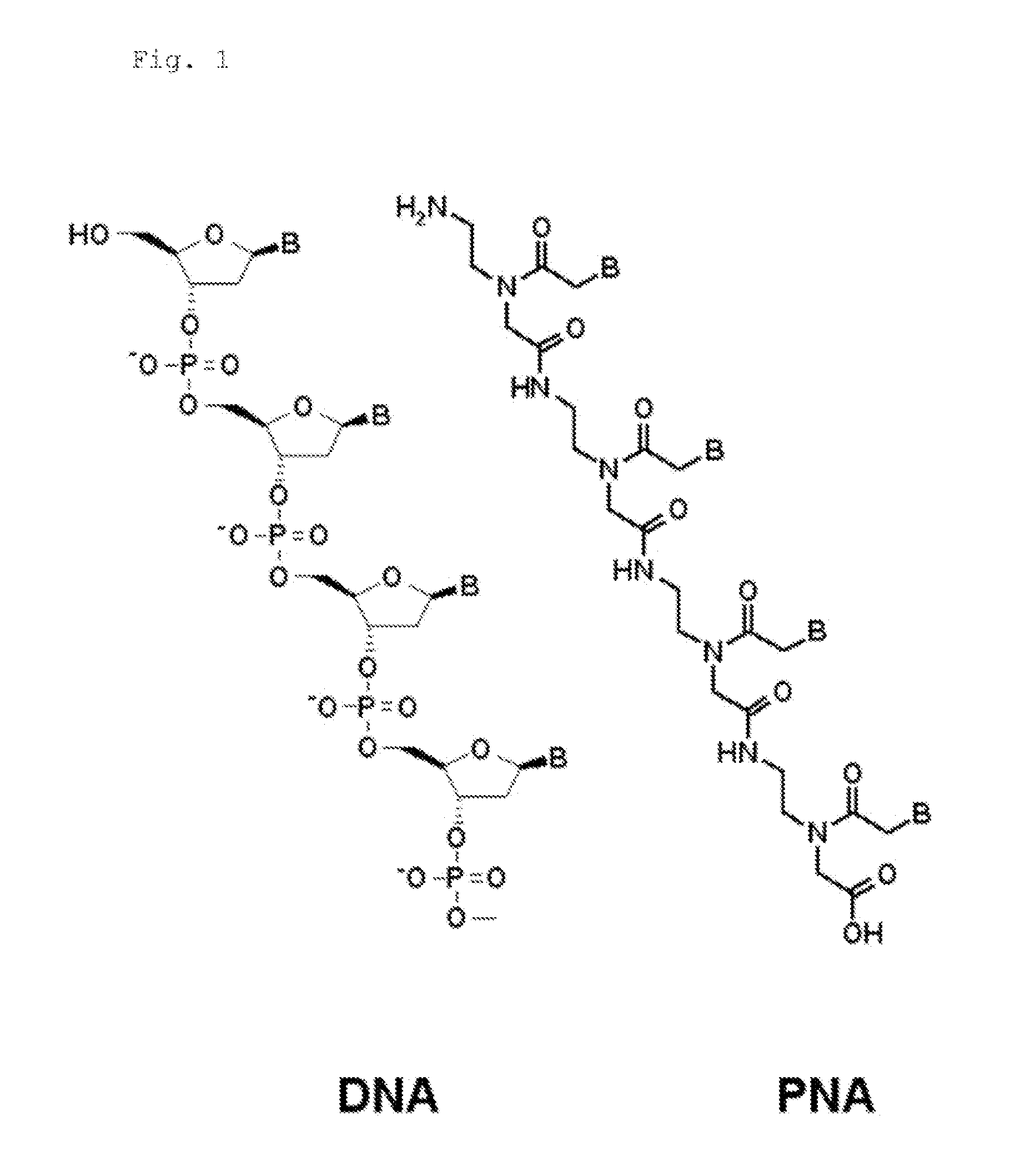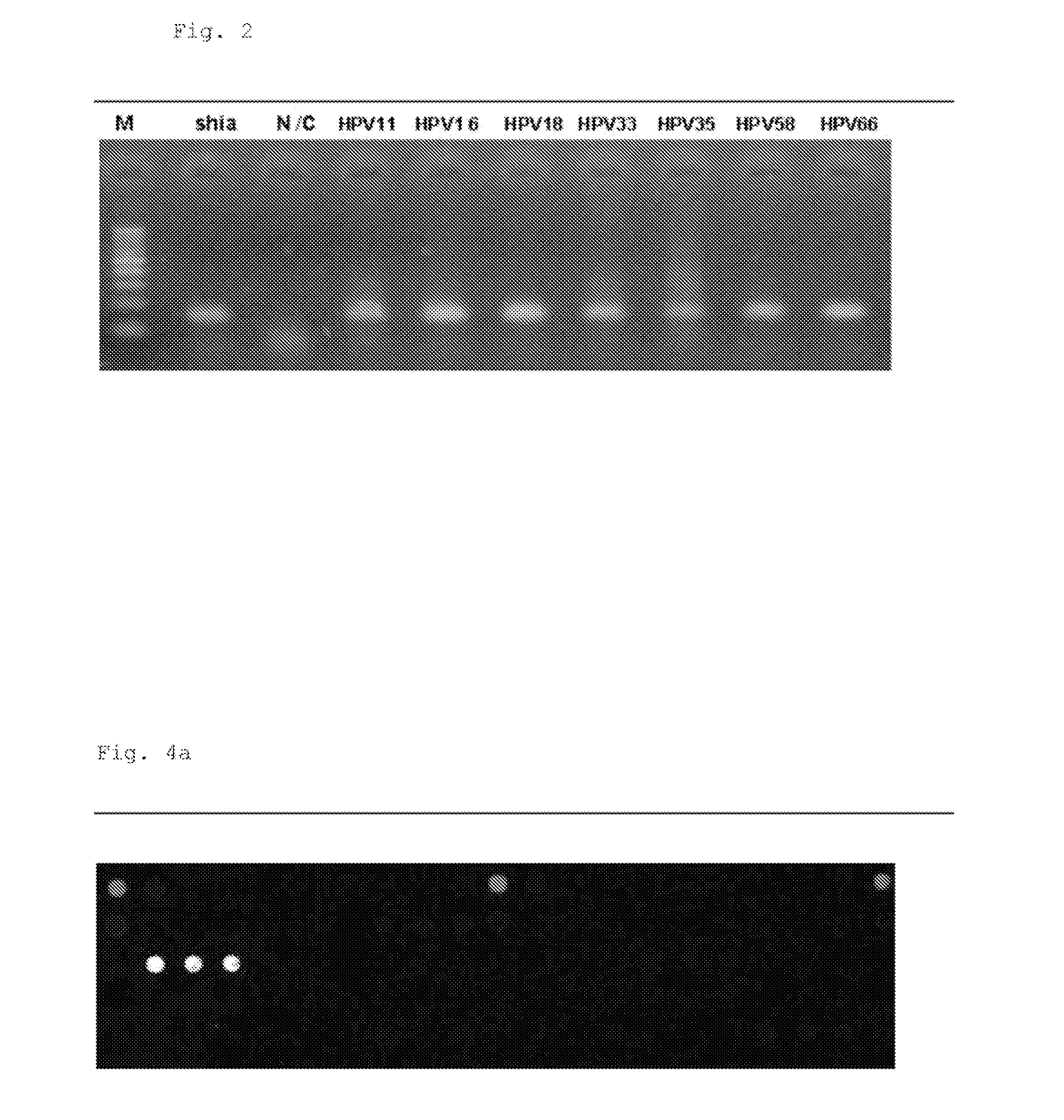PNA Probes, Kits, and Methods for Detecting Genotypes of Human Papillomavirus
a human papillomavirus and genotype technology, applied in the field of human papillomavirus genotype detection, can solve the problems of low sensitivity, high false negative rate of 30-40%, amplification of dna, etc., and achieve high specificity and sensitivity
- Summary
- Abstract
- Description
- Claims
- Application Information
AI Technical Summary
Benefits of technology
Problems solved by technology
Method used
Image
Examples
example 1
Synthesis of HPV PNA Oligomer
[0054]Twenty-four (24) PNA probes for the detection of HPV genotypes were prepared to have nucleotide sequences specific to each HPV genotype, as shown in Table 1. Each probe was synthesized to have a multi-amine linker at the N-terminus for immobilization on a glass slide.
[0055]1) Preparation of PNA Oligomer
[0056]According to the procedures described in Korean Patent Registration No. 464261, PNA oligomer was synthesized from PNA monomer protected with Bts (Benzothiazolesulfonyl) group and a functionalized resin by solid phase synthesis. 8-(9H-Fluoren-9-ylmethoxycarbonylamino)-3,6-dioxa-octanoic acid was introduced twice as a spacer at the N-terminus. PNA attached to the resin was employed for the subsequent reaction.
[0057]2) Preparation of PNA Probes Having Multi-Amine Linker
[0058]The PNA attached to the resin prepared from above 1) was treated with a solution of 1 M piperidine in DMF (dimethylformamide) to eliminate Fmoc protective group at the N-termi...
example 2
Synthesis of Primers for Preparing HPV Target DNA
[0059]HPV PCR primers were prepared from GP5+ / GP6+ primer sites according to the method of Jacobs et al. [J Clin Microbiol 35:791-795, 1997]. The primers had the nucleotide sequences as shown in the following Table 2.
TABLE 2Size ofNucleotide sequence (5′→3′) of primerPCR product (bp)Gp 5d +SenseTTTGTTACTGTGGTAGATACTAC130 bp(SEQ ID No. 25)Gp 6d +Anti-senseGAAAAATAAACTGTAAATCA(SEQ ID No. 26)
[0060]In order to ensure the emission of fluorescence after the hybridization, the primers were prepared to have 5′-labeled biotin, which binds with Streptavidin-cyanine 5 upon hybridization. The primers were synthesized by Bioneer Corporation in Korea.
example 3
Preparation of Recombinant HPV Clone
[0061]The clinical sample obtained from Biomedlab Co. (Korea) was amplified with the primers shown in Table 2, and PCR was carried out with various HPV genotypes. The PCR product was immediately inserted to pGEM-T-easy vector (from Promega, USA), and cloned to E. coli JM109 (from Stratagene, USA), and the genotype of HPV was identified by sequencing.
PUM
| Property | Measurement | Unit |
|---|---|---|
| diameter | aaaaa | aaaaa |
| humidity | aaaaa | aaaaa |
| period of time | aaaaa | aaaaa |
Abstract
Description
Claims
Application Information
 Login to View More
Login to View More - R&D
- Intellectual Property
- Life Sciences
- Materials
- Tech Scout
- Unparalleled Data Quality
- Higher Quality Content
- 60% Fewer Hallucinations
Browse by: Latest US Patents, China's latest patents, Technical Efficacy Thesaurus, Application Domain, Technology Topic, Popular Technical Reports.
© 2025 PatSnap. All rights reserved.Legal|Privacy policy|Modern Slavery Act Transparency Statement|Sitemap|About US| Contact US: help@patsnap.com



